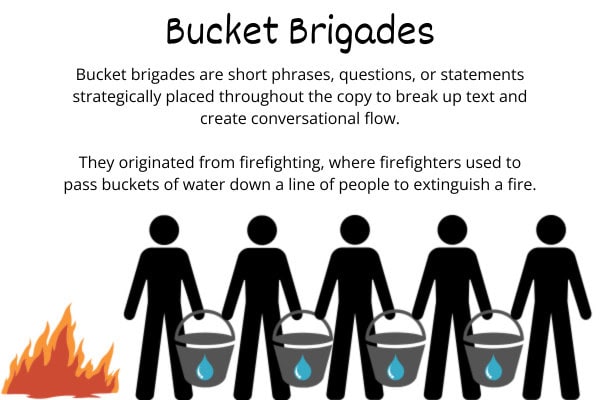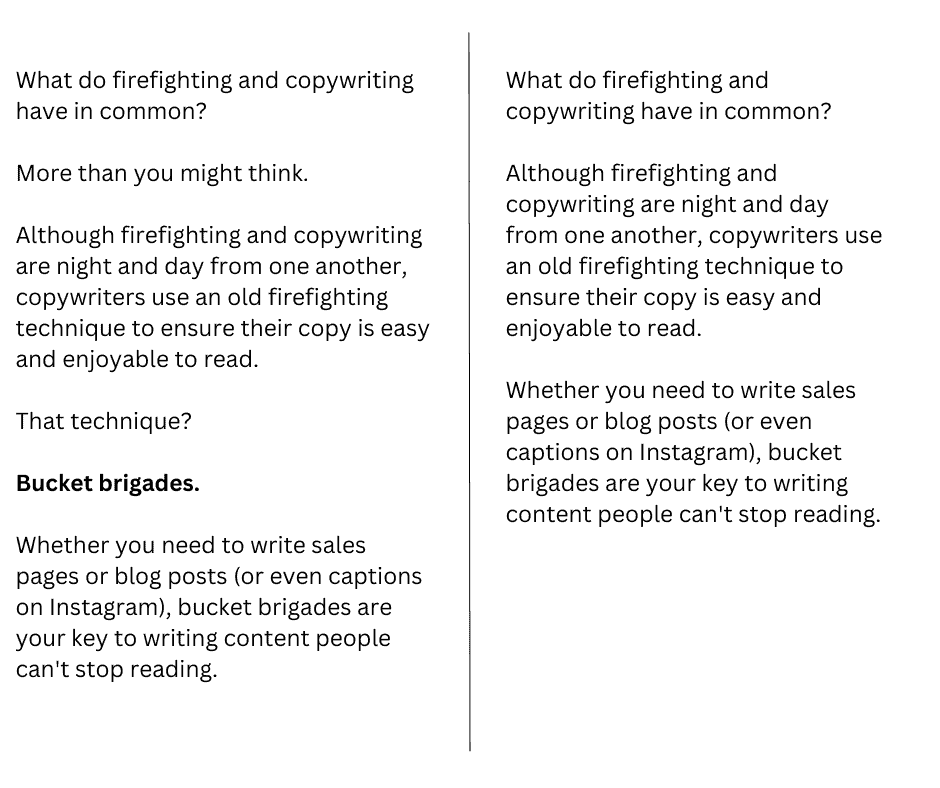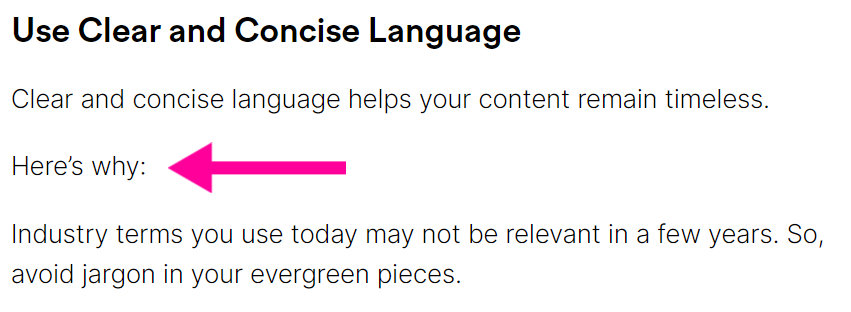Last Updated on
What do firefighting and copywriting have in common?
More than you might think.
Although firefighting and copywriting are night and day from one another, copywriters use an old firefighting technique to ensure their copy is easy and enjoyable to read.
That technique?
Bucket brigades.
Whether you need to write sales pages or blog posts (or even captions on Instagram), bucket brigades are your key to writing content people can’t stop reading.
What are bucket brigades in copywriting?
Bucket brigades are short phrases, questions, or statements strategically placed throughout the copy to break up text and create conversational flow.
Bucket brigades originated from firefighting, where firefighters used to pass buckets of water down a line of people to extinguish a fire.

Some time ago, smart copywriters borrowed that concept and began using phrases and words to keep their readers “passing” from one sentence to the next.
Like this.
Or like this.
These short sentences break up the text and make reading more enjoyable. As a bonus, they’re relatively easy to add to your copy, and you don’t need a Language Arts degree to start using them.
Examples of bucket brigades
While there’s no definitive list of bucket brigades, you can borrow a few common ones to add to your copy:
- Why?
- Why not?
- Here’s why.
- Here’s how.
- But that’s not all.
- So, what’s the solution?
- For example:
- Like this:
- One more thing you should know:
- Here’s the secret ingredient to…
- Let me share a powerful story with you.
- But here’s the truth.
- But what if I told you there’s an easier way?
- I know what you’re thinking:
- What does this mean for you?
- Which means:
- On the other hand:
- Here’s the bottom line:
- Let me explain.
- Not so fast.
- The secret?
- That’s right.
- You bet.
Even more, you can make up your own bucket brigades.
That’s right.
You don’t need to pull from any list.
Use what flows and what feels natural in your writing.
But for now, feel free to use the ones from the list above to familiarize yourself with them.
Why you should use bucket brigades
1. Bucket brigades increase engagement
Your copy becomes more intriguing when you use bucket brigades.
They create a sense of anticipation or excitement, keeping the reader engaged and interested in what comes next.
By using them strategically throughout your copy, you can keep your readers hooked from the first word to the last.
2. Bucket brigades improve readability
Short and snappy phrases throughout your copy make it scannable and easier to read than big text chunks.
👉 Here’s an example: the image’s left side shows this blog post’s introduction with bucket brigades. The right shows the text without any bucket brigades:

Although the one on the left is longer, it’s more readable and scannable.
3. Bucket brigades improve conversion rates
Bucket brigades ensure more people read through your copy and make it to your CTA.
Why?
Because as I’ve already mentioned, they improve the readability and flow of your copy.
Making it easier for people to get from point A (the start of your copy) to point B (your CTA).
And the more people who make it to your CTA, the higher your conversions should be.
How to identify areas to add in bucket brigades
A well-placed bucket brigade will smooth out clunky areas in your copy.
But how do you know where to put bucket brigades?
Place bucket brigades at places where the text feels like it’s lurching forward.
Here’s an example of a bucket brigade in a piece I recently wrote for Semrush:

Read through this passage without the “here’s why” bit. (This is the bucket brigade.)
While it’s not terrible, the two sentences feel disjointed without the added bucket brigade.
So, go through your writing and identify which areas aren’t flowing as well as you’d like.
Then, add a bucket brigade to improve the flow from one sentence to the next.
When to avoid bucket brigades
Bucket brigades are useful, but there are some instances where you should avoid them:
1. Formal content
Context matters. Leave out the bucket brigades in formal documents where conversational writing isn’t acceptable.
For example, bucket brigades may make research papers come across as unprofessional.
They’re also unacceptable in documents like press releases where you must convey a serious tone and message.
2. Content with character limits
With limited characters, bucket brigades might do more harm than good.
Adding extra words might detract from your original message, make your copy too long, and bury the main point.
For example, brevity is your friend if you need to create an ad on Twitter or draft a flyer.
In these cases, bucket brigades will likely harm your copy rather than elevate it.
Here’s an example of a flyer advertising vacation packages with bucket brigades used in the copy:

And here’s the same flyer without any bucket brigades:

The first one (with the bucket brigades) was cramped.
The second one gets straight to the point, which is necessary when working with space and character limits.
3. Lack of relevance
While bucket brigades can be powerful, excessive use without relevance is counterproductive.
If used too frequently or without purpose, your copy can become repetitive or gimmicky, leading to reader fatigue or loss of interest.
Here’s an example: Imagine you’re reading a blog post about how to boil an egg. It goes something like this:
Step 1: Get a pot and fill it with water.
Place the pot of water on the stove and turn your stove to high.
Why?
Because you need to boil the water.
Step 2: Get your egg.
Here’s how:
Walk to your fridge and open the door and pull out your egg.
You won’t believe what comes next.
Step 3: Place your egg in the boiling water
…you get the point. Sometimes, bucket brigades are entirely unnecessary. Before adding them, ensure they serve a purpose and add value to your content.
If your copy reads too gimmicky, you’re likely not putting your bucket brigades in the right places.
Give it a try
And that’s all, folks.
Whether you need to craft a post for social media or write an entire blog post, adding in bucket brigades is an easy way to transform your writing.
Give it a try and see for yourself.
P.S. Bookmark this post to return to the bucket brigade list when you’re stuck and need inspiration.
This article may include affiliate links. As an Amazon Associate I earn from qualifying purchases.

Dana Nicole is an award-winning freelance writer for MarTech/SaaS who was rated one of the best SaaS writers by Software World. She specializes in writing engaging content that ranks high in search engines and has been featured in publications like Semrush, ConvertKit, and Hotjar.
Dana holds a Bachelor’s degree in Business Administration and has over 15 years of experience working alongside national brands in their marketing departments.
When Dana’s not working, you can find her dancing en pointe, cooking up new recipes, and exploring the great outdoors with her two big dogs.

